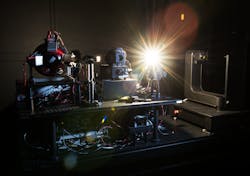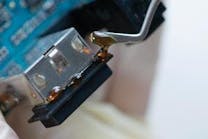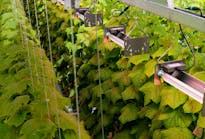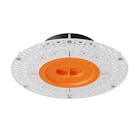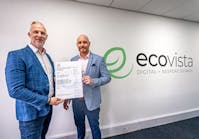Question: How many measurement scientists does it take to screw in an LED lightbulb? Answer: For researchers at the National Institute of Standards and Technology (NIST), half as many as it took a few weeks ago.
In June, NIST began offering a faster, more accurate and less labor-intensive calibration service for assessing the brightness of LED lamps and other solid-state lighting products. Customers for the service include LED lamp manufacturers, the U.S. military and other calibration laboratories.
Well-calibrated lights ensure that the 60-watt-equivalent LED bulb in your desk lamp truly is equivalent to 60 watts, for example, or that there is proper runway lighting for the pilot in a fighter plane.
LED manufacturers need to ensure that the lamps they make are really as bright as they designed them to be. To do that, they calibrate those lamps with a photometer, a tool that measures brightness at all wavelengths while taking into account the human eye’s natural sensitivities to different colors.
For decades, NIST’s photometry lab has been meeting the industry’s needs by offering an LED brightness and photometer calibration service. The service involves measuring the brightness of customers’ LEDs and other solid-state lamps, as well as calibrating the customers’ own photometers. Until recently, the NIST lab has measured lamp brightness with reasonably low uncertainties — between 0.5% and 1.0%, on par with mainstream calibration services.
Now, thanks to the lab revamp, the NIST team has reduced those uncertainties by a factor of three, to 0.2% or less. The achievement makes the new LED brightness and photometer calibration service one of the best — if not the best — in the world.
“We have now reduced all major uncertainties,” said NIST researcher Yuqin Zong.
The scientists have also cut the calibration time significantly. With the old system, it took almost a full day to do a single calibration for a customer. Most of that was devoted to setting up each measurement — swapping out a light source or a detector, manually checking distances between the two, and then reconfiguring the equipment for the next measurement, said NIST researcher Cameron Miller.
But now, the lab consists of two automated equipment tables, one for the light sources and the other for the detectors. The tables travel on a rail system that positions the detectors anywhere between 0 to 5 meters away from the lamps. The distances can be controlled to within 50 millionths of a meter (micrometers), which is about half the width of a human hair.
Zong and Miller can program the tables to move in relation to each other without requiring continuous human intervention. What used to take the better part of a day can now be done in hours.
“I don’t have to change any of the equipment anymore. Everything’s right here — all the instruments are in line, ready to be used,” Miller said. “It gives us a lot of freedom to do many things at the same time, because it’s completely automated. We could be back in our office doing other work while it’s running.”
NIST researchers say they expect their customer base to expand, since their lab has added several additional capabilities. For example, the new setup allows them to calibrate hyperspectral cameras, which measure many more wavelengths of light than typical video cameras, which usually capture only three or four colors. Hyperspectral cameras are becoming increasingly popular for everything from medical imaging to analyzing satellite footage of Earth. The information that space-based hyperspectral cameras provide about our planet’s weather and vegetation allows scientists to predict famines and floods and can help communities plan emergency response and disaster relief.
The new lab also allows researchers to more easily and efficiently calibrate smartphone displays and television and computer monitors.
Going the (Correct) Distance
To calibrate a customer’s photometer, NIST scientists used to illuminate the detector with a broadband light source — essentially a white light containing multiple wavelengths (or colors), whose brightness is extremely well understood because it is measured using NIST standard photometers. Unlike a laser light, this white light is incoherent, which means that all the different wavelengths of light are out of step with each other.
Ideally, to make the most accurate measurements, researchers would use light created by a tunable laser, whose wavelength can be controlled so that only a single wavelength of light at a time shines onto the detector. Using a tunable laser increases the signal-to-noise ratio of their measurements.
However, in the past, a tunable laser could not be used for calibrating photometers, because the single-wavelength laser light interferes with itself in a way that adds different amounts of noise to the signal depending on which wavelengths were used.
As part of their lab improvements, NIST’s Zong created a custom photometer design that has minimized this noise “to the point where it is negligible,” Miller said. This has made it possible, for the first time, to use a tunable laser for photometer calibration with small uncertainties.
The new design has the additional benefit of making the light collection equipment much easier to clean, since the delicate aperture is now protected behind a sealed window of glass.
Intensity measurements require knowing exactly how far a detector is from a light source. And until recently, like most other photometry labs, the NIST lab didn’t have a high-precision way to measure this distance. This is in part because the detector’s aperture, through which light is collected, is too delicate to be touched by measurement equipment.
One common workaround is that researchers first measure a light source’s illuminance — the amount of light emanating from a source and illuminating a surface with a certain area — at multiple distances. Next, they use that information to determine what those distances were using the inverse square law, which describes how a light source’s intensity decreases exponentially the farther you are from it. But this two-step measurement is not easy to implement and introduces additional uncertainties, Miller said.
With their new system, the team is now able to forgo the inverse square method and determine the distance directly.
The method uses microscope-based cameras. One microscope sits on the light source table and focuses on a position marker on the detector table. A second microscope sits on the detector table and focuses on a position marker on the light source table. Distances are determined by adjusting the detector’s apertures and the position of the light sources to the focal points of their respective microscopes.
“The microscopes are very sensitive to defocusing,” Zong said. “A few micrometers off, and the microscopes will tell you. They will blur the sharpness of the images.”
The new distance measurements have also allowed researchers to gauge the LEDs’ “true intensity,” a single number that indicates how much light the LED is putting out irrespective of distance.
A New Service for New Customers
In addition to these new capabilities, NIST scientists have also added instruments, such as a device called a goniophotometer, which allows them to rotate an LED lamp to measure how much light is emitted at different angles. In the next several months, Miller and Zong hope to adapt the goniophotometer for a new type of service: measuring LEDs’ ultraviolet (UV) output.
Potential uses for UV-producing LEDs include irradiation of food products to extend their shelf life, as well as sterilization of water supplies and medical equipment.
Traditionally, commercial irradiation has used UV light emitted by mercury vapor lamps. But in the past decade or so, companies have been trying to adapt LEDs for this purpose. The trouble is that no calibration labs are currently capable of calibrating these UV-producing LEDs.
NIST is trying to “think ahead of the curve” by having this capability ready for this “growing, evolving field,” Miller said. The researchers hope the new LED UV calibration service will be ready by the end of the year. -- Reported and written by Jennifer Lauren Lee
Contact:
Yuqin Zong
301-975-2332
